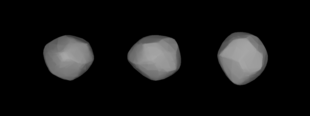(94) Aurora
|
Asteroid (94) Aurora |
|
|---|---|

|
|
| Shape of (94) Aurora - calculated from light reflection curves | |
| Properties of the orbit ( animation ) | |
| Orbit type | Outer main belt |
| Major semi-axis | 3.161 AU |
| eccentricity | 0.088 |
| Perihelion - aphelion | 2.882 AU - 3.44 AU |
| Inclination of the orbit plane | 8 ° |
| Length of the ascending node | 2.7 ° |
| Argument of the periapsis | 59.9 ° |
| Time of passage of the perihelion | November 15, 2008 |
| Sidereal period | 5 a 227 d |
| Mean orbital velocity | 16.7 km / s |
| Physical Properties | |
| Medium diameter | 205 km |
| Dimensions | (6.23 ± 3.64) 10 18 kg |
| Albedo | 0.0395 |
| Medium density | 1.83 ± 1.10 g / cm³ |
| Rotation period | 7 h 13 min |
| Absolute brightness | 7.57 likes |
| Spectral class | CP |
| history | |
| Explorer | JC Watson |
| Date of discovery | September 6, 1867 |
| Another name | A912 TC |
| Source: Unless otherwise stated, the data comes from JPL Small-Body Database Browser . The affiliation to an asteroid family is automatically determined from the AstDyS-2 database . Please also note the note on asteroid items. | |
(94) Aurora is an asteroid of the main outer belt discovered on September 6, 1867 by the American astronomer James Craig Watson in Ann Arbor .
The celestial body was named after Aurora , the Roman goddess of the dawn.
With a mean diameter of over 200 km, Aurora is one of the larger asteroids in the main belt. It has a dark, carbonaceous surface.
When a star occulted on October 12, 2001, an oval shape of the asteroid was detected.
See also
Individual evidence
- ↑ Benoit Carry Density of Asteriods , Planetary & Space Science, 2012, Volume 73, Edition 1, pp. 98–118, doi: 10.1016 / j.pss.2012.03.009
- ^ Discovery Circumstances: Numbered Minor Planets. The international Astronomical Union - Minor Planet Center, accessed August 5, 2020 .
- ↑ Observed Minor Planet Occultation Events . May 20, 2002. Archived from the original on April 10, 2008. Retrieved June 19, 2010.